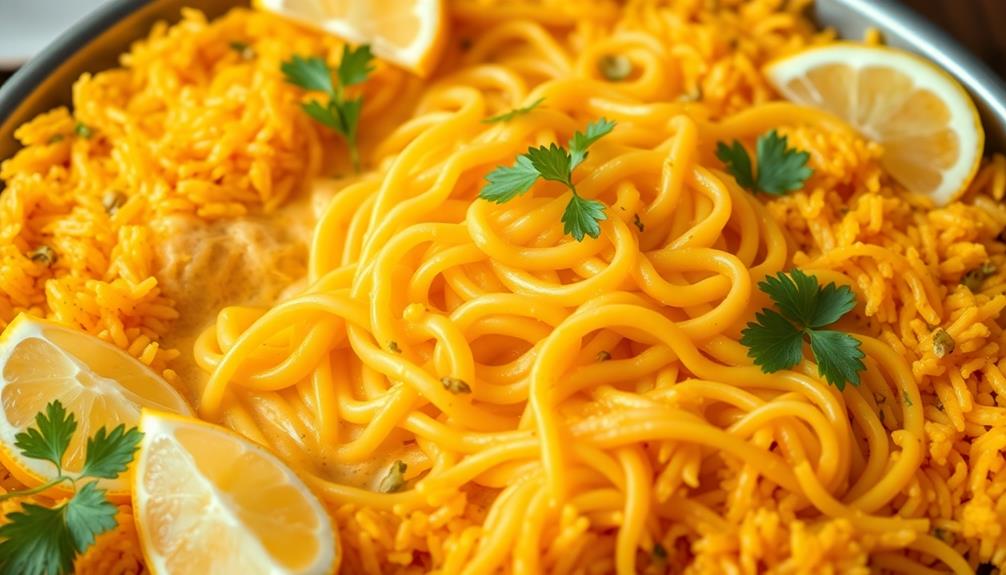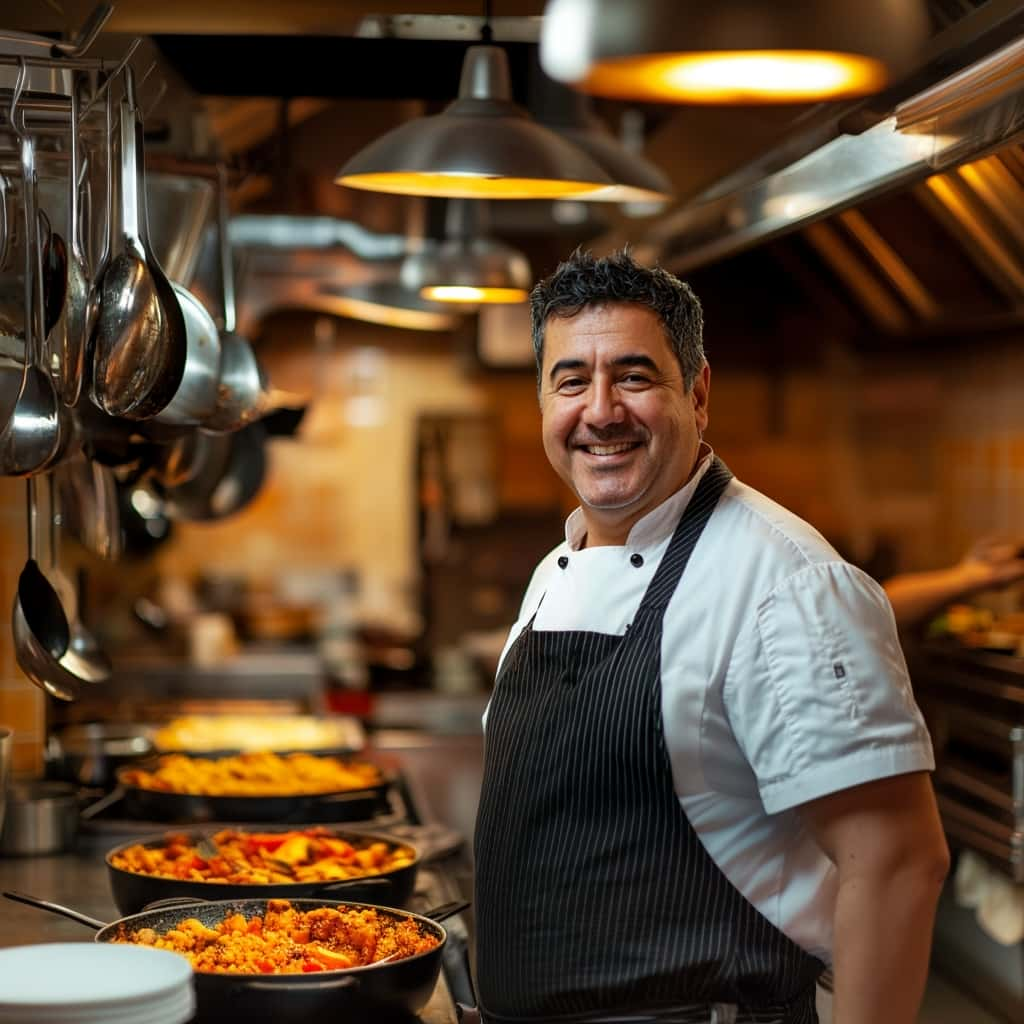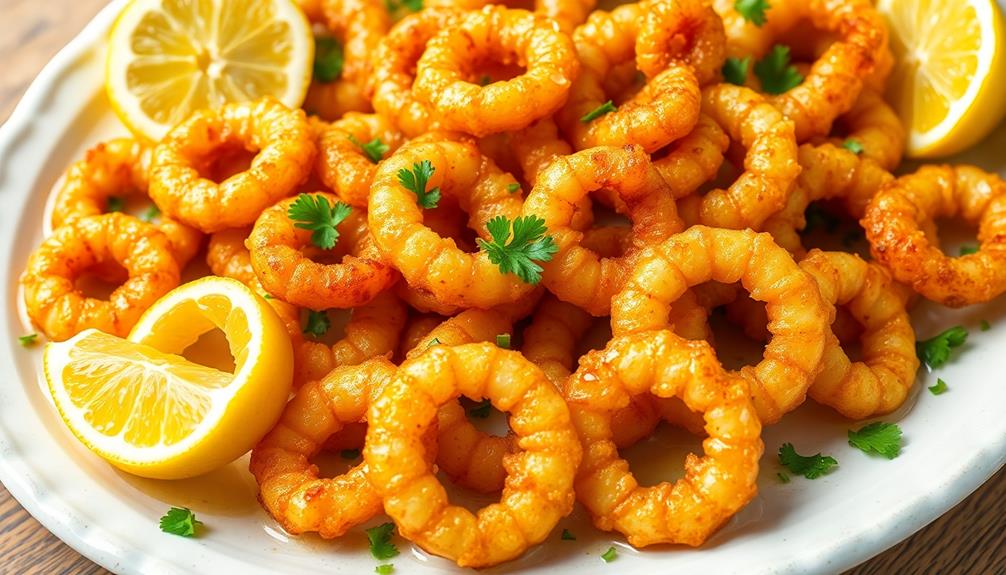Fideuà is a cherished Spanish dish from the coastal Valencia region, closely related to paella but starring thin, short noodles instead of rice. Tracing its roots back to the 18th century, this culinary treasure reflects the history and customs of the area, with recipes passed down through generations. You'll find it cooked in a wide, shallow pan called a "fideuera," typically featuring a mix of seafood like shrimp and squid, plus aromatic spices like smoked paprika. Fideuà is known for its harmonious blend of flavors and visual appeal, fostering social connections during communal dining experiences. Intrigued to learn more?
Key Takeaways
- Fideuà is a traditional Spanish dish from the Valencia region, made with short, thin noodles instead of rice.
- The dish is cooked in a wide, shallow pan called a "fideuera" and typically features seafood such as shrimp, squid, and monkfish.
- Fideuà has deep roots in Spanish culinary heritage, with regional variations influenced by local ingredients and cooking techniques.
- The preparation of fideuà involves toasting the noodles for a crispy texture and sautéing aromatics and seafood to create a harmonious blend of flavors.
- Fideuà is celebrated for its visual appeal, rich flavor profile, and ability to foster social connections during communal dining experiences.
History
The origins of fideuà can be traced back to the coastal regions of Spain. This traditional pasta dish is closely related to paella, with its roots dating back to the 18th century.
Fideuà is made with short, thin noodles that are cooked in a pan, similar to the way paella is prepared. The noodles are typically toasted before cooking, which gives them a unique flavor and texture.
The dish is then finished with a variety of seafood, such as shrimp, squid, and clams. Some versions also incorporate vegetables like bell peppers and onions. If desired, the dish can be finished with a sprinkle of fresh herbs, such as parsley or cilantro, for added flavor. Padrón peppers are a popular addition to this dish, adding a mild and slightly sweet heat. To incorporate padrón peppers into the dish, simply sauté them in a hot pan with a little oil until they blister and char slightly, then serve alongside the seafood and vegetables. If you’re unsure how to cook padrón peppers, it’s important to note that they are best enjoyed when cooked quickly over high heat to preserve their unique flavor and texture.
Fideuà is often served as a celebratory meal, particularly during festivals and gatherings. It's a beloved part of Spanish culinary heritage, with each region having its own unique interpretation.
Whether you're enjoying it at a beachside restaurant or preparing it at home, fideuà is a delicious and authentic taste of Spain.
Recipe
Fideuà is a traditional dish from the Valencia region of Spain, similar to paella but made with short, thin noodles instead of rice. This dish is a delicious and unique way to enjoy the flavors of the Mediterranean.
Fideuà is typically cooked in a wide, shallow pan called a "fideuera," which allows the noodles to cook evenly and develop a crispy texture. The dish is often made with a variety of seafood, such as shrimp, squid, and sometimes even sliced monkfish or clams.
Ingredients:
- 1 lb short, thin noodles (such as fideus, or you can use vermicelli or linguine broken into 1-inch pieces)
- 1 lb mixed seafood (such as shrimp, squid, and monkfish or clams)
- 1 onion, diced
- 3 cloves of garlic, minced
- 1 tomato, diced
- 1 cup fish or seafood stock
- 1 tsp smoked paprika
- 1/4 cup olive oil
- Salt and pepper to taste
Instructions:
In a large, shallow pan or fideuera, heat the olive oil over medium-high heat. Add the onion and garlic and sauté until fragrant and translucent.
Add the tomato and sauté for another 2-3 minutes. Add the noodles and toss to coat with the oil, then pour in the fish or seafood stock.
Arrange the seafood on top of the noodles, sprinkle with smoked paprika, and season with salt and pepper. Cover the pan and cook for 12-15 minutes, or until the noodles are tender and the seafood is cooked through.
To ensure the best texture, be sure not to overcrowd the pan and allow the noodles to develop a crispy bottom layer. Serve the fideuà immediately, garnished with lemon wedges if desired.
Cooking Steps
First, you'll need to soak the fideuà noodles in water until they've softened.
Drain them well and then toast the noodles in a pan to get them nice and crispy.
Next, sauté the aromatics like garlic and onions in olive oil before adding your seafood.
Step 1. Soak Fideuà Noodles in Water
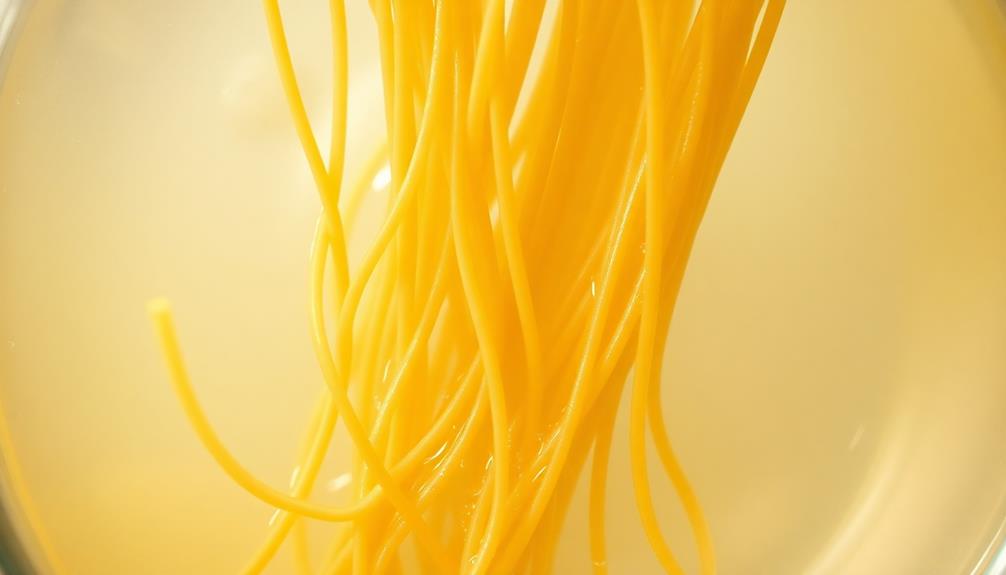
Soak the noodles in a bowl of water for about 30 minutes. This softens the fideuà noodles, preparing them for the next steps.
The noodles should be completely submerged, so add enough water to cover them. Once they've soaked, drain the noodles in a colander, gently pressing to remove any excess water.
Now that the noodles are ready, you can move on to the next part of the recipe. Gather your other ingredients and cooking tools, as the fideuà will come together quickly from here.
The soaked noodles are the foundation, so taking the time to properly hydrate them ensures the final dish has the perfect texture. With the noodles prepped, you're one step closer to enjoying this classic Spanish seafood paella-style dish.
Step 2. Drain and Toast Noodles

After draining the soaked noodles in a colander, you'll want to toast them briefly in a large skillet or pan over medium heat. This step helps to crisp up the noodles and adds a delightful nutty flavor.
Be sure to keep a close eye on them, stirring frequently, as they can easily go from perfectly toasted to burnt. Once the noodles are lightly golden and fragrant, you can remove them from the heat.
Next, you'll want to transfer the toasted noodles to a plate or baking sheet to cool slightly. This will prevent them from continuing to cook and becoming too crunchy.
Once they've cooled for a minute or two, you can move on to the next step in the recipe. Remember to handle the noodles gently to avoid breaking them.
With a little care, you'll have perfectly toasted fideuà noodles, ready to be incorporated into the rest of your dish.
Step 3. Sauté Aromatics in Olive Oil
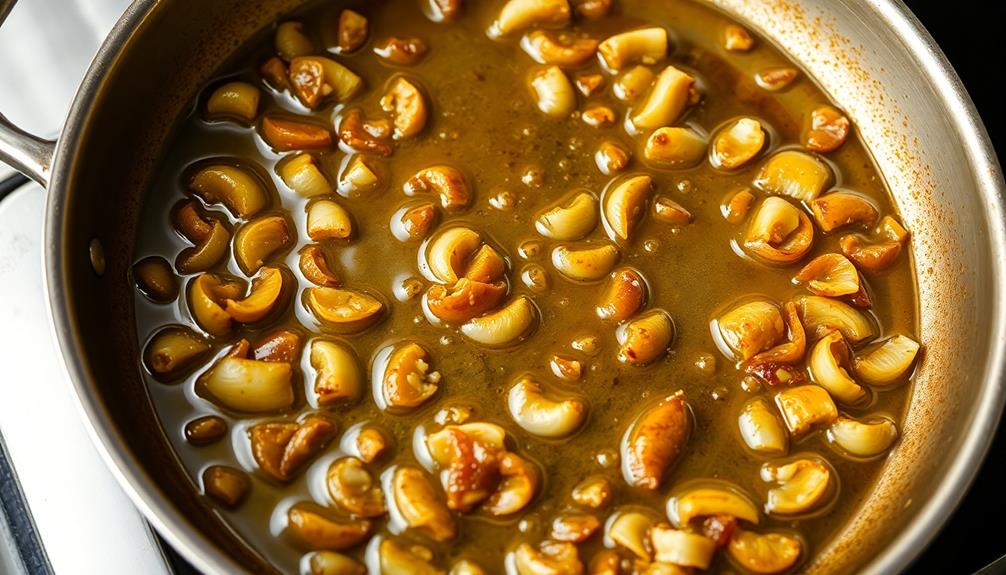
With the noodles toasted and cooled, you can now move on to sautéing the aromatics in olive oil.
In a large skillet, heat a few tablespoons of olive oil over medium heat. Once the oil is shimmering, add the chopped onions and garlic. Sauté the aromatics, stirring frequently, until they become fragrant and the onions are translucent, about 5 to 7 minutes.
Next, add any other aromatics, like diced bell peppers or minced herbs, and continue sautéing for another 2 to 3 minutes.
The key is to cook the aromatics until they're soft and the flavors have melded, but not let them burn. This step lays the foundation for the dish's complex flavor profile.
Once the aromatics are perfectly sautéed, you're ready to move on to the next step.
Remember to adjust the heat as needed to prevent burning, and enjoy the enticing aroma filling your kitchen!
Step 4. Add Seafood
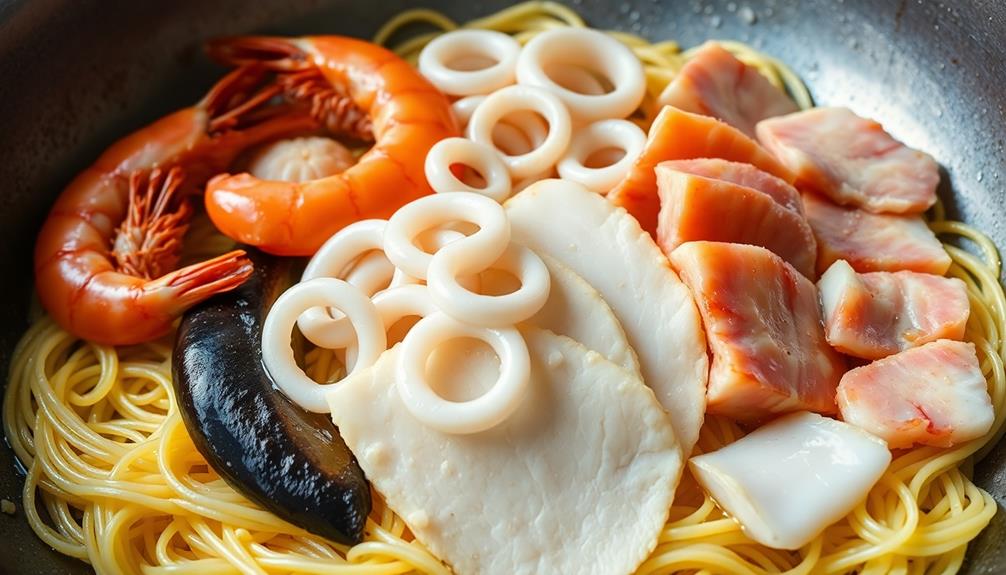
Next, add your choice of seafood to the sautéed aromatics. Shrimp, calamari, or chunks of white fish work wonderfully.
Gently place the seafood in the pan and let it sizzle for a few minutes, allowing the flavors to mingle. Stir occasionally to ensure even cooking. The seafood should turn opaque and develop a delicate texture. For a touch of brightness, consider squeezing in some fresh lemon juice. This will help balance the richness of the olive oil and bring out the natural sweetness of the seafood.
Once the seafood is cooked through, it's time to add the noodles. Carefully arrange the fideuà noodles over the seafood, nestling them into the pan.
Allow the noodles to toast and crisp up, about 2-3 minutes per side. Keep a close eye to prevent burning. The end result should be a harmonious blend of tender seafood and toasted, caramelized noodles.
Step 5. Add Rice and Simmer
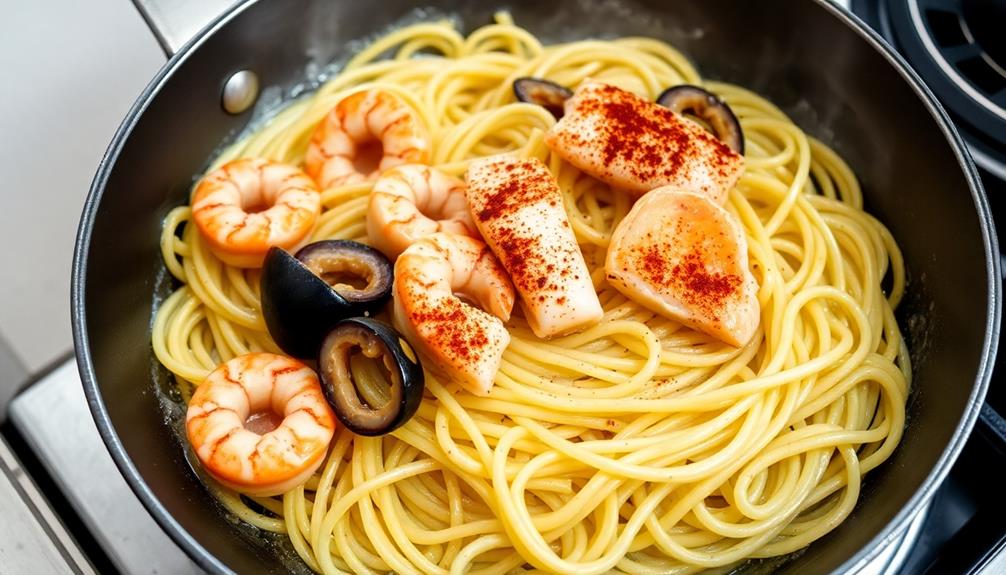
Once the seafood and noodles have come together, it's time to add the rice and let the dish simmer to perfection. Grab a cup of short-grain rice and give it a good rinse under cold water. This will help remove any excess starch and ensure the grains don't stick together.
Next, add the rinsed rice to the pan with the simmering noodles and seafood. Gently stir to incorporate the rice and make sure it's evenly distributed.
Then, pour in just enough broth or water to cover the rice, being careful not to overwhelm the dish. Let the mixture come back to a gentle simmer, then reduce the heat to low.
Cover the pan with a tight-fitting lid and let it cook for 15-20 minutes, until the rice is tender and has absorbed all the flavorful liquid. Resist the urge to lift the lid and peek, as this can disrupt the cooking process.
Once the time is up, remove the pan from the heat and let it sit for a few minutes before serving. This gives the rice a chance to finish cooking and the flavors to meld together beautifully.
Fluff it with a fork and enjoy your delicious Fideuà with perfectly cooked rice.
Final Thoughts
Fideuà has undoubtedly left an indelible mark on the culinary landscape, captivating the hearts and palates of food enthusiasts worldwide. This beloved Spanish dish has transcended regional boundaries, becoming a global sensation. As you savor the final bites, you can't help but reflect on the journey of flavors you've experienced.
The perfectly cooked, al dente noodles, the rich, simmered broth, and the harmonious blend of aromatic spices all come together in a symphony of taste. Each forkful is a testament to the culinary artistry and cultural heritage that Fideuà represents.
Whether you've been a longtime devotee or a newfound admirer, the impact of Fideuà is undeniable. It's a dish that brings people together, sparking conversations, sharing memories, and creating lasting culinary experiences.
As you bid farewell to this delightful meal, you can't help but feel a sense of gratitude for the joy it has brought and the anticipation of the next time you'll indulge in its deliciousness.
Frequently Asked Questions
What Is the Origin of the Name Fideuà?
You're curious about the origin of the name, aren't you? It's likely derived from the Spanish word "fidel," meaning "loyal" or "faithful," reflecting the dish's traditional preparation and ingredients. The name likely evolved over time to become the familiar "fideuà" we know today.
Is Fideuà Traditionally Made With Seafood or Can It Be Vegetarian?
Traditionally, fideua can be made with seafood, but it can also be prepared as a vegetarian dish. The choice of ingredients depends on personal preference and regional culinary traditions. You can explore both options to find your favorite version.
How Long Does It Typically Take to Prepare Fideuà?
Preparing the dish typically takes around an hour, though the exact time can vary depending on the complexity of the recipe and your level of experience. Gather all the necessary ingredients and don't rush the process for best results.
Can Fideuà Be Made in Advance and Reheated?
You can certainly make it in advance and reheat it. The dish holds up well, and reheating won't compromise the texture or flavor. Just be sure to store it properly and reheat it gently to preserve the best quality.
Is There a Specific Type of Pasta Used in Fideuà?
Yes, there is a specific type of pasta used in this dish. It's typically made with a short, thin noodle similar to vermicelli or angel hair pasta. This pasta shape helps create the signature texture of the fideuà dish.
